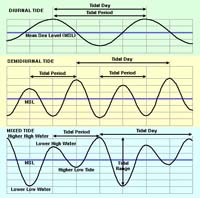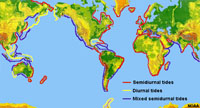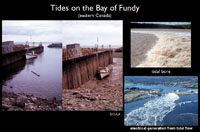11.4: Types of Tidal Cycles and Regional Tidal Variations
- Page ID
- 10323
Types of Tidal Cycles
If the Earth were a perfect sphere with no continents, all parts of the planet would have two equally proportioned low and high tides every lunar day as the Earth rotates. However, the large continental land masses block the westward movement of the tidal bulges. This blocking of the tidal bulges results in the development of complex tidal patterns within each ocean basin. As a result, different parts of ocean basins have different types of tides (Figures 10-7 and 10-8).

- Diurnal Tides—a region where there is only one high tide and one low tide each lunar day. For example, the Gulf of Mexico has diurnal tides.
- Semidiurnal Tides—a region that experience 2 high tides and two low tides of approximately equal size each lunar day. For example, the Atlantic Coast of North America has semidiurnal tides.
- Mixed Semidiurnal Tides—a region where the two high tides and two low tides differ in height. For example, West Coast of the North America (including here in San Diego) has mixed semidiurnal tides.
Regional Tidal Variations
Tidal ranges vary considerably around the world and are influenced by factors including shoreline and continental shelf geometries, latitude, size of the body of water, and other factors (Figure 11.8). For instance, the equatorial regions have very minimal tides compared with higher latitudes. Like all ocean currents, tidal currents are influenced the influence of the Coriolis effect. Ebb and flood currents influenced by the Coriolis effect create circular flow patterns in large bays.
The Bay of Fundy has the highest tidal range in the world! Check out:
Bay of Fundy Tides, New Brunswick and Nova Scotia YouTube video
Fall and rise of the tide in the Bay of Fundy - Time Lapse YouTube video
Bay of Fundy Tide, Time-lapse, Fundy National Park YouTube video




